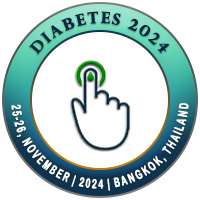
Tzvetelina Totomirova
Clinic of Endocrinology and Metabolic Diseases, BulgariaTitle: Which is better: HbA1c or Continuous Glucose Monitoring (CGM) for Treatment Adjustment in Patients with Type 2 Diabetes?
Abstract
Guideline treatment recommendations in patients with type 2 diabetes are focused predominantly on HbA1c. HbA1c shows insufficiency in glucose control assessment with omitting glucose fluctuations, variability and hypoglycemic episodes. Continuous glucose monitoring (CGM) was used for insulin dose adjustment in pump treated patients but it could be used in type 2 diabetes patient treatment determination.
We compare results derived from retrospective CGM and HbA1c to find out their usefulness for drug prescription decision in patients with type 2 diabetes.
We studied 85 patients with type 2 diabetes (35 women, 50 men; age 43.93±10.87 years, disease duration 21.91±6.07 years). Patients received different treatment regimens (31 on oral therapy, 33 treated with premixed insulin, 21 on multiple insulin injections). They performed Non-Real Time Continuous Glucose Monitoring by using iProTM for seven days and HbA1c was measured at the end of this period. HbA1c level was to be similar in three groups. There was moderate negative correlation between HbA1c and percentage of time in range derived from CGM (r1= -0.654; r2= -0.674; r3= -0.521) with no dependence on therapeutic regimen. Moderate positive correlation was found between HbA1c and time spent above the range and moderate negative correlation with time in range for all groups. CGM was more informative than HbA1c in defining patients with good or bad control (p<0.05). HbA1c correlates badly with overall glucose excursion (r1=-0.096, r2=0.200, r3=0.377). There was no difference between studied groups in regard to CGM percentage of time in range, above and below the range, as well as to AUC above upper limit.
We confirm that CGM is more precise than HbA1c in diabetes control assessment and in treatment adjustment. It could be used in patients follow up for achievement of optimal results.
Biography
To be added

